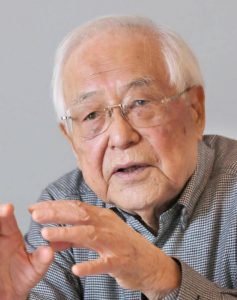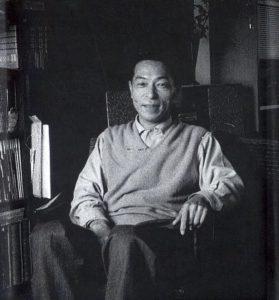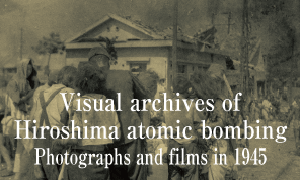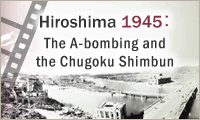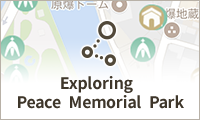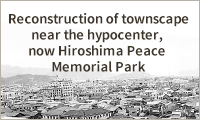My guidepost, Hiroshima pioneers: Takashi Hiraoka, 95, former Hiroshima mayor—Toshihiro Kanai
Jan. 16, 2023
Former mayor poses questions about “nuclear might” from human side
Takashi Hiraoka visited South Korea as the first reporter at the Chugoku Shimbun to cast light on the issue of A-bomb survivors in South Korea suffering from poverty and discrimination. While serving as mayor of Hiroshima, Mr. Hiraoka continued to assert the inhumanity of nuclear weapons. Consistent was his mindset of considering the nuclear issue from a human perspective.
In gaining that perspective, he was greatly influenced by Toshihiro Kanai (1914–1974), a senior staff writer at the Chugoku Shimbun. “I learned from Mr. Kanai firsthand about what to focus on as a writer in Hiroshima and how to be relentless in pursuing a story,” said Mr. Hiraoka.
Chief editorial writer at the newspaper, Mr. Kanai was the person who posed the question, “Have the atomic bombs come to be known for their power, or for their human tragedy?” He promoted the campaign to produce an “A-bomb White Paper,” insisting that the true destruction caused by the atomic bombings was not being accurately reported. He was at the forefront of the effort to collect materials for the white paper. He put together a philosophy developed through the movement, systematically presented arguments against nuclear weapons, and trained many followers. Mr. Hiraoka identifies himself as a student of the so-called “Kanai School.”
Mr. Hiraoka met his mentor soon after joining the media company. Although he started work at the newspaper based on his desire to write articles, he was initially assigned work at a desk in charge of creating page layouts. Initially, Mr. Hiraoka marketed his skills to Mr. Kanai, then working in the arts and society department, by submitting such manuscripts as translations of German magazine articles, ultimately leading to Mr. Kanai’s adoption of articles by Mr. Hiraoka written under a pseudonym. In 1961, Mr. Kanai’s maneuvering behind the scenes led to Mr. Hiraoka’s transfer to Mr. Kanai’s department. That is where his career covering the atomic bombing began. Mr. Kanai taught Mr. Hiraoka to not only trace superficial phenomena but to dig down deep into the peace movement from an ideological perspective.
In following A-bomb survivor group activities and the “Ban the Bomb” movement, Mr. Hiraoka naturally found many opportunities to engage with individual A-bomb survivors and come into contact with their very real suffering. “It was hard for me because the more I spoke with A-bomb survivors in my reporting, the more I could see their distress. But, that’s how the issue became personal for me,” he said.
In the summer of 1965, he was charged with creating a feature series titled “20 Years after the Bombing,” along with a chronological table of events in that time period. Laboring with colleagues, he laid the foundation for reporting on the atomic bombing from the perspective of those forced to endure the suffering.
One day, a letter arrived to the Chugoku Shimbun from a man in South Korea who had experienced the atomic bombing in Hiroshima and was hoping to undergo medical treatment in Japan. Mr. Hiraoka was ashamed that he had not been aware of the presence of such individuals even though he knew that Koreans had experienced the atomic bombing during the time Korea had been under Japan’s colonial rule.
In 1965, the year diplomatic relations were restored between Japan and South Korea, he visited that country at his own expense. He reported about the distressing situation of the A-bomb survivors in Korea, who had been forgotten, arguing for the need to provide them with assistance. He also supported the trial of Son Jin-doo, an A-bomb survivor in South Korea who had illegally entered Japan to seek medical treatment. At the same time, he continued to sound the alarm about Japan’s evasion of its responsibilities in that history. Those views also led him to Mr. Kanai.
As Mr. Hiraoka engaged in the work of compiling Eighty Years’ History of the Chugoku Shimbun (published in 1972), team members found themselves at loggerheads about how to describe the Chugoku Shimbun’s responsibilities in the war. “Based on my reading of the newspapers published during the war, I insisted that our company’s chronology include its own responsibility in having stirred up readers by parroting incorrect information put out by Japan’s military government at the time,” said Mr. Hiraoka. “However, most of the team members believed there was no reason in particular to leave a record of our own shame.” Mr. Kanai, who headed the compilation effort, was decisive. “It is shameful to have made a mistake but it would be more shameful to try and hide it.” In the end, descriptions about the newspaper’s mistakes of that kind were left in the publication. Mr. Hiraoka said, “I learned a lot of things from Mr. Kanai, but that situation was particularly impressive to me.”
Even after assuming the post of mayor of Hiroshima, Mr. Hiraoka continued to convey information about the atomic bombing of the city from a human perspective. His 1991 Peace Declaration included the words, “Japan inflicted great suffering and despair on the peoples of Asia and the Pacific during its reign of colonial domination and war. There can be no excuse for these actions.” In 1995, he spoke at the International Court of Justice (ICJ), located in the Hague, the Netherlands, asserting that nuclear weapons were illegal. His statement led to the ICJ’s advisory opinion the following year indicating that the threat or use of nuclear weapons “would generally be contrary to the rules of international law.”
Mr. Hiraoka said, “People’s ignorance and disinterest in damage caused by nuclear weapons will allow further adoption of the theory of nuclear deterrence. It should never be forgotten that the nuclear issue is political, and that people in power have their fingers on the nuclear buttons.” He has continued to be critical of nuclear might, a theme that Mr. Kanai also touched on in his writings.
Profile
Takashi Hiraoka
Born in Osaka, Mr. Hiraoka, together with his family, moved to the Korean Peninsula in 1937, and he spent his boyhood in Seoul. He returned to Hiroshima in September 1945. After graduating from Waseda University, he joined the Chugoku Shimbun. Having served in such posts as editor-in-chief of the newspaper and president of RCC Broadcasting, he assumed the office of Hiroshima mayor, in 1991, for two terms over a span of eight years. He continues to help provide medical support to those who were affected by the former Soviet Union’s nuclear testing. Mr. Hiraoka now lives in Hiroshima’s Nishi Ward.
Keyword
“A-Bomb White Paper” campaign
A movement called for by Toshihiro Kanai at a joint meeting held in Hiroshima in 1964 among three prefectures affected by atomic and hydrogen weapons. Insisting that the Japanese government take responsibility for identifying the entire picture of devastation wrought by the atomic bombings, he called for development of the white paper and for it to be shown to the world through its submission to the United Nations. The campaign gained momentum, with involvement by universities, governments, the media, and the public, and included publication of a comprehensive record of information about the A-bombing damage that comprehensively covered documents and video materials, as well as a hypocenter reconstruction effort. However, ultimately, the white paper effort was left unfinished.
(Originally published on January 16, 2023)

